2nd in these series is setting up a virtual Cumulus VX Clos-fabric and connect it to our NSX setup from our previous article, including VTEP integration!
For this we need to expand our LAB environment:
- Freesco Router (for dns, ntp and internet)
- Management switch (gns3 builtin)
VXLAN Router (Cisco 3640) (not really a vxlan router, but creates an L3 hop between the ESXi hosts, and so it routes the VXLAN packets)- VMware vCenter Server Appliance 6.5.0d
- Two VMware ESXi 6.5.0d hosts
- NSX Manager 6.3.2
- NSX Controller 6.3.2 (3 for HA, but 1 works just fine in the lab)
- Two test vm's (we chose alpine linux for this occasion) running on esx1 & esx2
- Four Cumulus VX 3.5.0 switches consisting of two spines and two leafs.We started building the lab on Cumulus VX 3.3.2 though, and it's possible the configuration differs somewhat between the two. One big change between them is that Cumulus Linux 3.4 and later releases replaces Quagga with FRRouting.
- Two test "physical" servers (we chose damn small linux) connected to the leafs
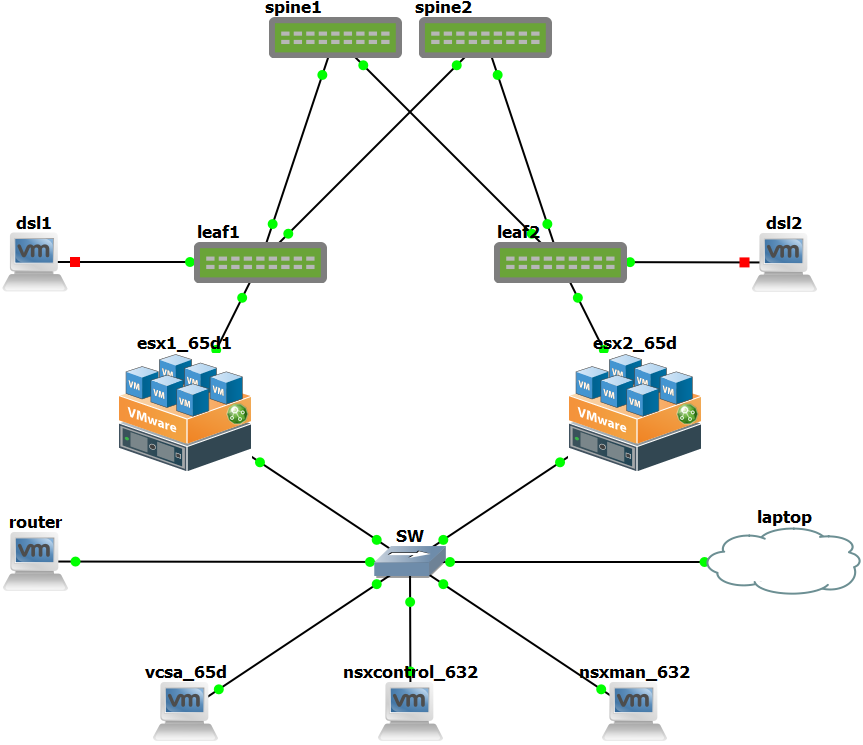
Lab IP Address plan
| MGMT Network |
|
|
|
| Default gateway |
10.10.100.1 |
|
|
| DNS |
10.10.100.1 |
|
|
| Domain |
cumuluslab |
|
|
| |
|
|
|
| router |
10.10.100.1/24 |
|
|
| spine1 |
10.10.100.11/24 |
|
|
| spine2 |
10.10.100.12/24 |
|
|
| leaf1 |
10.10.100.13/24 |
|
|
| leaf2 |
10.10.100.14/24 |
|
|
| vsca |
10.10.100.20/24 |
|
|
| esx1 |
10.10.100.21/24 |
|
|
| esx2 |
10.10.100.22/24 |
|
|
| nsxcont |
10.10.100.23/24 |
|
|
| nsxman |
10.10.100.24/24 |
|
|
| laptop |
10.10.100.30/24 |
|
|
| |
|
|
|
| VXLAN Network |
|
|
|
| esx1 vxlan vmk1 |
10.10.101.1/30 |
MTU |
1500 |
| leaf1 vtep |
10.10.101.2/30 |
MTU |
1500 |
| esx2 vxlan vmk1 |
10.10.101.9/30 |
MTU |
1500 |
| leaf2 vtep |
10.10.101.10/30 |
MTU |
1500 |
| |
|
|
|
| VXLAN Client Network |
|
|
|
| alpine01 |
10.10.200.11/24 |
MTU |
1400 |
| alpine02 |
10.10.200.12/24 |
MTU |
1400 |
| dsl1 |
10.10.200.13/24 |
MTU |
1400 |
| dsl2 |
10.10.200.14/24 |
MTU |
1400 |
SPINE & LEAF interface configuration
| SPINE1 - /etc/network/interfaces & NCLU |
SPINE2 - /etc/network/interfaces & NCLU |
# The loopback network interface
auto lo
iface lo inet static
address 10.10.102.11
netmask 255.255.255.255
# The primary network interface
auto eth0
iface eth0 inet static
address 10.10.100.11
netmask 255.255.255.0
gateway 10.10.100.1
# Uplinks
auto swp1
iface swp1
auto swp2
iface swp2
|
# The loopback network interface
auto lo
iface lo inet static
address 10.10.102.12
netmask 255.255.255.255
# The primary network interface
auto eth0
iface eth0 inet static
address 10.10.100.12
netmask 255.255.255.0
gateway 10.10.100.1
# Uplinks
auto swp1
iface swp1
auto swp2
iface swp2
|
#spine01
net add loopback lo ip address 10.10.102.11/32
net add interface eth0 ip address 10.10.100.11/24
net add routing route 0.0.0.0/0 10.10.100.1
net commit
|
#spine02
net add loopback lo ip address 10.10.102.12/32
net add interface eth0 ip address 10.10.100.12/24
net add routing route 0.0.0.0/0 10.10.100.1
net commit
|
| LEAF1 - /etc/network/interfaces & NCLU |
LEAF2 - /etc/network/interfaces & NCLU |
# The loopback network interface
auto lo
iface lo inet loopback
address 10.10.102.13
netmask 255.255.255.255
# The primary network interface
auto eth0
iface eth0 inet static
address 10.10.100.13
netmask 255.255.255.0
gateway 10.10.100.1
# Uplinks
auto swp1
iface swp1
auto swp2
iface swp2
# ESX1
auto swp3
iface swp3 inet static
address 10.10.101.2
netmask 255.255.255.252
mtu 1500
auto swp4
iface swp4
auto swp5
iface swp5
auto swp6
iface swp6
|
# The loopback network interface
auto lo
iface lo inet loopback
address 10.10.102.14
netmask 255.255.255.255
# The primary network interface
auto eth0
iface eth0 inet static
address 10.10.100.14
netmask 255.255.255.0
gateway 10.10.100.1
# Uplinks
auto swp1
iface swp1
auto swp2
iface swp2
# ESX2
auto swp3
iface swp3 inet static
address 10.10.101.10
netmask 255.255.255.252
mtu 1500
auto swp4
iface swp4
auto swp5
iface swp5
auto swp6
iface swp6
|
#leaf01
net add loopback lo ip address 10.10.102.13/32
net add interface eth0 ip address 10.10.100.13/24
net add routing route 0.0.0.0/0 10.10.100.1
net add interface swp3 ip address 10.10.101.2/30
net add interface swp3 mtu 1500
|
#leaf02
net add loopback lo ip address 10.10.102.14/32
net add interface eth0 ip address 10.10.100.14/24
net add routing route 0.0.0.0/0 10.10.100.1
net add interface swp3 ip address 10.10.101.10/30
net add interface swp3 mtu 1500
|
SPINE & LEAF routing configuration
To turn the Cumulus switches into an EVPN fabric, we enable BGP as the routing protocol.
We establish peering between all neighbors (leaf1 to spine1 and spine2, leaf2 to spine1 and spine2)
| SPINE1 - /etc/quagga/Quagga.conf & NCLU |
SPINE2 - /etc/quagga/Quagga.conf & NCLU |
!
interface swp1
ipv6 nd ra-interval 10
no ipv6 nd suppress-ra
!
interface swp2
ipv6 nd ra-interval 10
no ipv6 nd suppress-ra
!
interface swp3
ipv6 nd ra-interval 10
no ipv6 nd suppress-ra
!
interface swp4
ipv6 nd ra-interval 10
no ipv6 nd suppress-ra
! enabling BGP
router bgp 65020
bgp router-id 10.0.0.21
bgp bestpath as-path multipath-relax
! we configure a peer-group to put all the fabric nodes in and configure their capabilities.
neighbor fabric peer-group
neighbor fabric remote-as external
neighbor fabric description Internal Fabric Network
neighbor fabric capability extended-nexthop
! we configure the switchports to be in the peer-group we just created.
neighbor swp1 interface peer-group fabric
neighbor swp2 interface peer-group fabric
neighbor swp3 interface peer-group fabric
neighbor swp4 interface peer-group fabric
! we enable the default adress-families for L3 routing between VTEP endpoints
address-family ipv4 unicast
! add loopback interface to BGP (this is the VTEP endpoint on this switch)
network 10.0.0.21/32
redistribute connected
exit-address-family
!
address-family ipv6 unicast
neighbor fabric activate
exit-address-family
! we enable the EVPN af this is the EVPN VXLAN control-plane protocol.
address-family evpn
neighbor fabric activate
exit-address-family
!
|
!
interface swp1
ipv6 nd ra-interval 10
no ipv6 nd suppress-ra
!
interface swp2
ipv6 nd ra-interval 10
no ipv6 nd suppress-ra
!
interface swp3
ipv6 nd ra-interval 10
no ipv6 nd suppress-ra
!
interface swp4
ipv6 nd ra-interval 10
no ipv6 nd suppress-ra
! enabling BGP
router bgp 65020
bgp router-id 10.0.0.22
bgp bestpath as-path multipath-relax
! we configure a peer-group to put all the fabric nodes in and configure their capabilities.
neighbor fabric peer-group
neighbor fabric remote-as external
neighbor fabric description Internal Fabric Network
neighbor fabric capability extended-nexthop
! we configure the switchports to be in the peer-group we just created.
neighbor swp1 interface peer-group fabric
neighbor swp2 interface peer-group fabric
neighbor swp3 interface peer-group fabric
neighbor swp4 interface peer-group fabric
! we enable the default adress-families for L3 routing between VTEP endpoints
address-family ipv4 unicast
! add loopback interface to BGP (this is the VTEP endpoint on this switch)
network 10.0.0.22/32
redistribute connected
exit-address-family
!
address-family ipv6 unicast
neighbor fabric activate
exit-address-family
! we enable the EVPN af this is the EVPN VXLAN control-plane protocol.
address-family evpn
neighbor fabric activate
exit-address-family
!
|
#spine01
net add bgp autonomous-system 65020
net add bgp router-id 10.0.0.21
net add bgp bestpath as-path multipath-relax
net add bgp neighbor fabric peer-group
net add bgp neighbor fabric remote-as external
net add bgp neighbor fabric description Internal Fabric Network
net add bgp neighbor fabric capability extended-nexthop
net add bgp neighbor swp1 interface peer-group fabric
net add bgp neighbor swp2 interface peer-group fabric
net add bgp ipv4 unicast network 10.0.0.21/32
net add bgp ipv4 unicast redistribute connected
net add bgp ipv6 unicast neighbor fabric activate
net add bgp evpn neighbor fabric activate
|
#spine02
net add bgp autonomous-system 65020
net add bgp router-id 10.0.0.22
net add bgp bestpath as-path multipath-relax
net add bgp neighbor fabric peer-group
net add bgp neighbor fabric remote-as external
net add bgp neighbor fabric description Internal Fabric Network
net add bgp neighbor fabric capability extended-nexthop
net add bgp neighbor swp1 interface peer-group fabric
net add bgp neighbor swp2 interface peer-group fabric
net add bgp ipv4 unicast network 10.0.0.22/32
net add bgp ipv4 unicast redistribute connected
net add bgp ipv6 unicast neighbor fabric activate
net add bgp evpn neighbor fabric activate
|
| LEAF1 - /etc/quagga/Quagga.conf & NCLU |
LEAF2 - /etc/quagga/Quagga.conf & NCLU |
!
interface swp1
ipv6 nd ra-interval 10
no ipv6 nd suppress-ra
!
interface swp2
ipv6 nd ra-interval 10
no ipv6 nd suppress-ra
! enabling BGP
router bgp 65011
bgp router-id 10.0.0.11
bgp bestpath as-path multipath-relax
! we configure a peer-group to put all the fabric nodes in and configure their capabilities.
neighbor fabric peer-group
neighbor fabric remote-as external
neighbor fabric description Internal Fabric Network
neighbor fabric capability extended-nexthop
! we configure the switchports to be in the peer-group we just created.
neighbor swp1 interface peer-group fabric
neighbor swp2 interface peer-group fabric
! we enable the default adress-families for L3 routing between VTEP endpoints
address-family ipv4 unicast
! add loopback interface to BGP (this is the VTEP endpoint on this switch)
network 10.0.0.11/32
redistribute connected
exit-address-family
!
address-family ipv6 unicast
neighbor fabric activate
exit-address-family
! we enable the EVPN af this is the EVPN VXLAN control-plane protocol.
address-family evpn
neighbor fabric activate
! provision all locally configured VNIs to be advertised by the BGP control plane.
advertise-all-vni
exit-address-family
!
|
!
interface swp1
ipv6 nd ra-interval 10
no ipv6 nd suppress-ra
!
interface swp2
ipv6 nd ra-interval 10
no ipv6 nd suppress-ra
! enabling BGP
router bgp 65012
bgp router-id 10.0.0.12
bgp bestpath as-path multipath-relax
! we configure a peer-group to put all the fabric nodes in and configure their capabilities.
neighbor fabric peer-group
neighbor fabric remote-as external
neighbor fabric description Internal Fabric Network
neighbor fabric capability extended-nexthop
! we configure the switchports to be in the peer-group we just created.
neighbor swp1 interface peer-group fabric
neighbor swp2 interface peer-group fabric
! we enable the default adress-families for L3 routing between VTEP endpoints
address-family ipv4 unicast
! add loopback interface to BGP (this is the VTEP endpoint on this switch)
network 10.0.0.12/32
redistribute connected
exit-address-family
!
address-family ipv6 unicast
neighbor fabric activate
exit-address-family
! we enable the EVPN af this is the EVPN VXLAN control-plane protocol.
address-family evpn
neighbor fabric activate
! provision all locally configured VNIs to be advertised by the BGP control plane.
advertise-all-vni
exit-address-family
!
|
#leaf01
net add bgp autonomous-system 65011
net add bgp router-id 10.0.0.11
net add bgp bestpath as-path multipath-relax
net add bgp neighbor fabric peer-group
net add bgp neighbor fabric remote-as external
net add bgp neighbor fabric description Internal Fabric Network
net add bgp neighbor fabric capability extended-nexthop
net add bgp neighbor swp1 interface peer-group fabric
net add bgp neighbor swp2 interface peer-group fabric
net add bgp ipv4 unicast network 10.0.0.11/32
net add bgp ipv4 unicast redistribute connected
net add bgp ipv6 unicast neighbor fabric activate
net add bgp evpn neighbor fabric activate
net add bgp evpn advertise-all-vni
|
#leaf02
net add bgp autonomous-system 65012
net add bgp router-id 10.0.0.12
net add bgp bestpath as-path multipath-relax
net add bgp neighbor fabric peer-group
net add bgp neighbor fabric remote-as external
net add bgp neighbor fabric description Internal Fabric Network
net add bgp neighbor fabric capability extended-nexthop
net add bgp neighbor swp1 interface peer-group fabric
net add bgp neighbor swp2 interface peer-group fabric
net add bgp ipv4 unicast network 10.0.0.12/32
net add bgp ipv4 unicast redistribute connected
net add bgp ipv6 unicast neighbor fabric activate
net add bgp evpn neighbor fabric activate
net add bgp evpn advertise-all-vni
|
Setup VTEP Integration
The next step is integrating the "hardware" VTEP with NSX.
Now hardware-VTEP-integration is cool because we can manage physical ports from NSX and add these into a NSX logical switch, bringing the physical world into the virtual world.
Also check Cumulus DOCS for a comprehensive step-by-step.
1. Configure the NSX Replication Cluster
Networking & Security > Service Definitions > Hardware Devices > Replication Cluster > Edit.
The replication cluster will be responsible for forwarding the broadcast traffic sent from a hardware VTEP.

2. Configure openvswitch-vtep on both Cumulus leaf switches
Run these command on both leaf switches:
sudo systemctl enable openvswitch-vtep.service
sudo systemctl start openvswitch-vtep.service
3. Bootstrap both Cumulus leaf switches
LEAF1:
sudo vtep-bootstrap --credentials-path /var/lib/openvswitch --controller_ip 10.10.100.23 leaf1 10.10.102.13 10.10.100.13
LEAF2:
sudo vtep-bootstrap --credentials-path /var/lib/openvswitch --controller_ip 10.10.100.23 leaf2 10.10.102.14 10.10.100.14
4. Configure the switch as a VTEP gateway
For LEAF1 grab (copy) the public key content from LEAF1:/var/lib/openvswitch/leaf1-cert.pem and add this BASE64 begin/end request to the Certificate field while adding the Hardware Device, also enable BFD.
Networking & Security > Service Definitions > Hardware Devices > Hardware Devices > Click +.
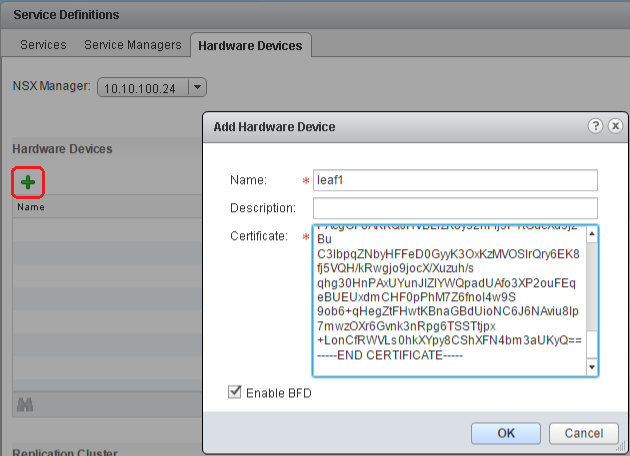
Do the same for LEAF2 : LEAF2:/var/lib/openvswitch/leaf2-cert.pem

5. Bring the physical server switch port into the virtual world
Goto Networking & Security > Logical Switches and click Manage Hardware Bindings from the Actions menu of your logical switch.
Add leaf1:swp2 (the physical port connected to DSL1) to the logical switch. Do this for both physical servers LEAF1:DSL_server1 and LEAF2:DSL_server2!
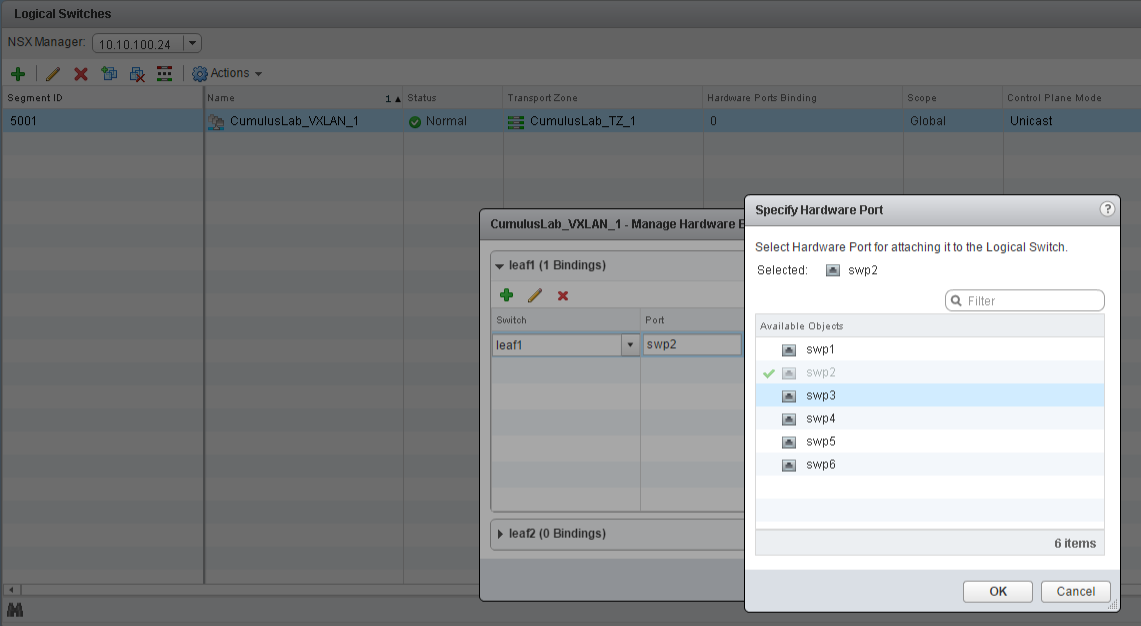
Verify our setup
And we're done! Let's look at our LAB and test it!
We've got two DSL VM's running on ESX1 and ESX2 and two DSL physical servers connected to LEAF1 and LEAF2. All four nodes are connected to the same VXLAN, this was possible due to the hardware VTEP integration between NSX and Cumulus, cool right?!?

It's an older image, but setup is the same
Let's do some final pings tests:
|
DSL_VM01
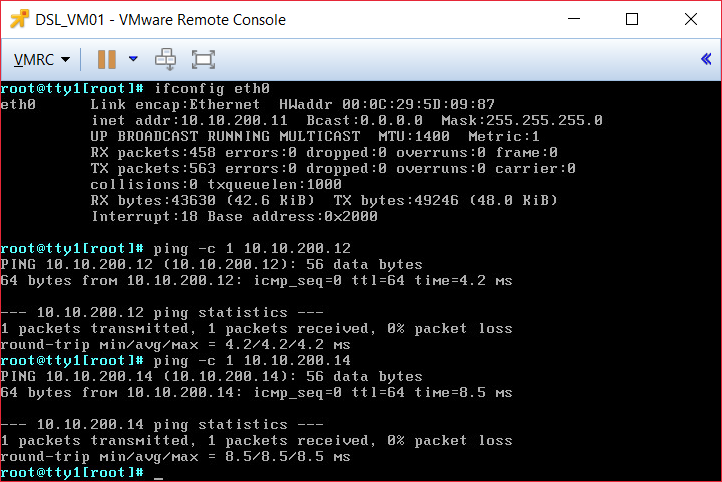
|
DSL_VM02
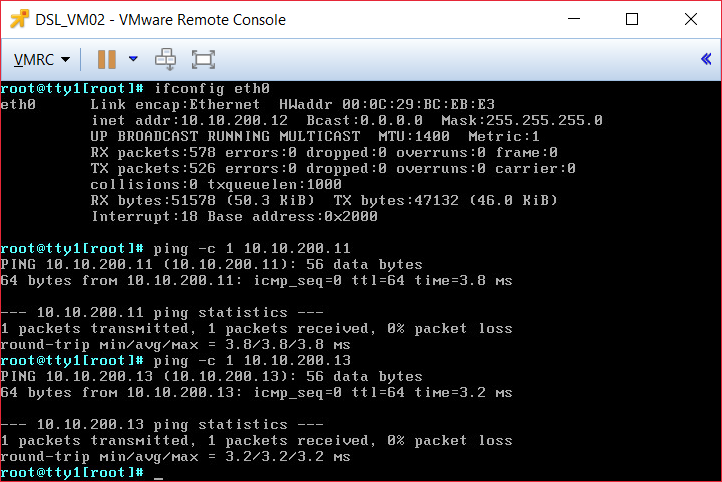
|
|
DSL_SERVER01
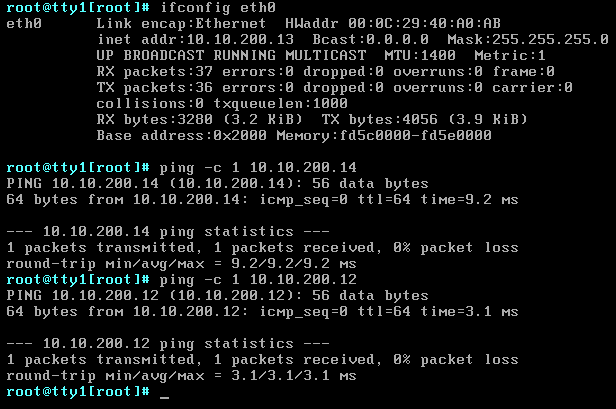
|
DSL_SERVER02
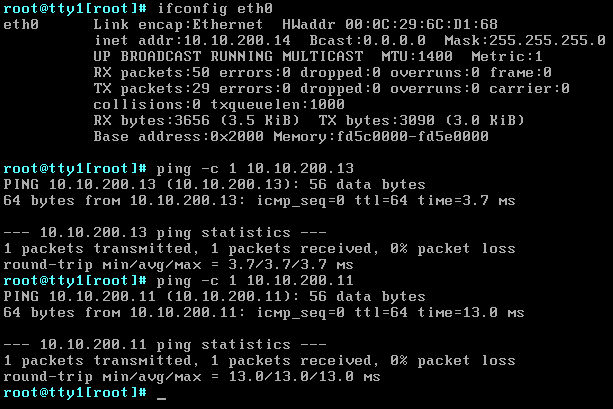
|
And done...
Next up is adding redundancy to the network, how... wait and see!
Articles in these series
https://scict.nl/nsx-cumulus-part1-en/
https://scict.nl/nsx-cumulus-part2-en/
https://scict.nl/nsx-cumulus-part3-en/
SHARE THIS POST










